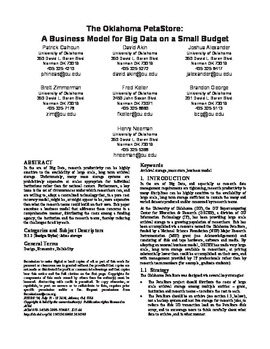| dc.description | 1. INTRODUCTION
In the era of Big Data, and especially as research data management requirements are tightening, research productivity in many disciplines can be highly sensitive to the availability of large scale, long term storage sufficient to contain the many and varied datasets produced and/or consumed by research teams.
At the University of Oklahoma (OU), the OU Supercomputing Center for Education & Research (OSCER), a division of OU Information Technology (IT), has been providing large scale archival storage to a growing population of researchers. This has been accomplished via a resource named the Oklahoma PetaStore, funded by a National Science Foundation (NSF) Major Research Instrumentation (MRI) grant (see Acknowledgements) and consisting of disk and tape hardware, software and media. By adopting an unusual business model, OSCER has made very large scale, long term storage available to researchers, at pricing substantially lower than could be accomplished on their own, and with management provided by IT professionals rather than by research team members (for example, graduate students). | en_US |
| dc.description.abstract | ABSTRACT
In the era of Big Data, research productivity can be highly sensitive to the availability of large scale, long term archival storage. Unfortunately, many mass storage systems are prohibitively expensive at scales appropriate for individual institutions rather than for national centers. Furthermore, a key issue is the set of circumstances under which researchers can, and are willing to, adopt a centralized technology that, in a pure cost recovery model, might be, or might appear to be, more expensive than what the research teams could build on their own. This paper examines a business model that addresses these concerns in a comprehensive manner, distributing the costs among a funding agency, the institution and the research teams, thereby reducing the challenges faced by each.
Categories and Subject Descriptors
B.3.2 [Design Styles]: Mass storage
General Terms
Design, Economics, Reliability
Permission to make digital or hard copies of all or part of this work for personal or classroom use is granted without fee provided that copies are not made or distributed for profit or commercial advantage and that copies bear this notice and the full citation on the first page. Copyrights for components of this work owned by others than the author(s) must be honored. Abstracting with credit is permitted. To copy otherwise, or republish, to post on servers or to redistribute to lists, requires prior specific permission and/or a fee. Request permissions from Permissions@acm.org.
XSEDE '14, July 13 - 18 2014, Atlanta, GA, USA
Copyright is held by the owner/author(s). Publication rights licensed to ACM.
ACM 978-1-4503-2893-7/14/07…$15.00. http://dx.doi.org/10.1145/2616498.2616548
Keywords
Archival storage, mass store, business model | en_US |
